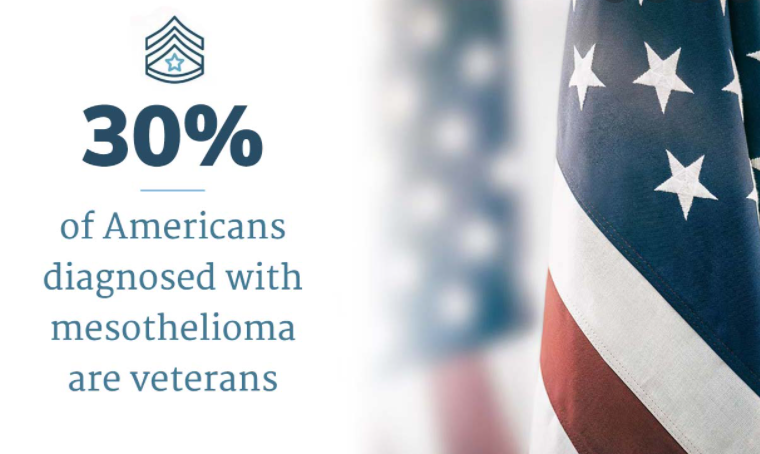It wasn’t until the long-term health risks of asbestos gained considerable publicity in the mid-1970s that the military reduced its use. Exposure to asbestos can be a serious health risk causing mesothelioma if asbestos-containing material is disturbed in such a way that the particles and fibers become airborne, and unfortunately many veterans are not far from this exposure.
What is Mesothelioma?
Malignant mesothelioma is a rare cancer that develops in the mesothelium, the protective linings that cover various organs.
This type of cancer most commonly affects the linings of the lungs (pleura) or abdomen (peritoneum). In rare cases, mesothelioma tumors can grow in the linings of the heart (pericardium) or testes (tunica vaginalis).
Only around 3,000 Americans are diagnosed with mesothelioma each year. The most common type of this condition is pleural mesothelioma, accounting for 80% of all cases. Peritoneal mesothelioma accounts for 10% of all cases, whereas pericardial and testicular mesothelioma make up a very small percentage of cases.
What Causes Mesothelioma?
Asbestos exposure is the only known cause of mesothelioma. Asbestos is a naturally-occurring mineral that resists exposure to fire, sound, water, and chemicals. It is composed of millions of fibers, which bind together to create a light yet virtually indestructible material.
When asbestos products are disturbed, the fibers may be inhaled or ingested. Then, the asbestos fibers may lodge themselves into the tissue linings of various organs. Once the fibers become stuck, they damage healthy tissue. In some cases, this tissue damage causes cancerous tumors to form.
It can take 20-50 years of irritation from asbestos fibers before the symptoms of mesothelioma become noticeable. By this point, the cancer may have spread throughout the body.
Most cases of mesothelioma are not diagnosed until after the cancer has spread to other areas in the body, making it harder to treat. However, if mesothelioma is caught early on, patients may be able to live several years after their diagnosis.
From the 1930s to the early 1980s, asbestos was widely used in several industries and the military. Therefore, many mesothelioma patients are U.S. military veterans or blue-collar workers. Loved ones of those exposed to asbestos were also at-risk of developing mesothelioma due to secondhand exposure.
Veterans and Asbestos Exposure
U.S. veterans are at an especially high health risk of mesothelioma, a cancer caused by asbestos exposure. Every branch of the military relied on asbestos from the 1930s to the early 1980s because the mineral was cheap and resistant to fire and heat.
Asbestos-containing products could be found in military aircrafts, bases, equipments, ships, vehicles. The military was unaware of the dangers of asbestos because manufacturers withheld this information from the government, private industries, and the general public.
Due to these manufacturers’ wrongdoing, you may be eligible for VA benefits and other forms of compensation if you developed mesothelioma as a result of your active duty.
Mesothelioma Treatment Options
The two categories for malignant mesothelioma treatment include curative and palliative treatment. Curative treatments are given to help extend a patient’s lifespan, whereas palliative treatments manage symptoms and reduce discomfort. Doctors generally use the same mesothelioma treatments to achieve curative or palliative goals.
The three most common types of mesothelioma treatment include chemotherapy, radiation, and surgery.
Mesothelioma specialists will often prescribe multimodal therapy, which is a combination of multiple types of mesothelioma treatment. Customized treatment plans are designed to help you live as long as possible.
Researchers continue to study new ways to treat mesothelioma through clinical trials including immunotherapy, gene therapy, target therapy, and more.







You must be logged in to post a comment.